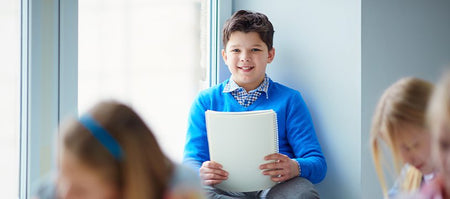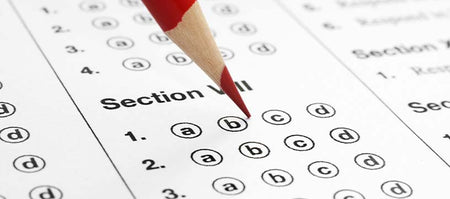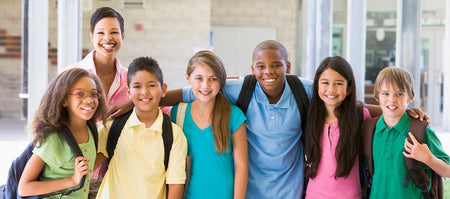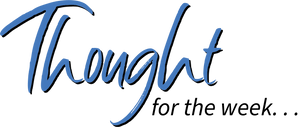
The opening of school this year featured a variety of distractions, pressures, and expectations for everyone in the education community. Students were returning from a year of disruption that threatened to carry over into the new year. Educators were asked to “catch students up” with curricular expectations despite wide variations in readiness for new learning and the ongoing presence of the virus. Families worried about virus spread mitigation efforts while also wondering whether their children’s learning would continue to suffer from ongoing pandemic challenges.
Certainly, there are reasons for concern about the current context for learning. Still, the challenges we face do not have to diminish the wonder and delight learning brings. We can choose to focus on the distractions or we can choose to deal with challenges while also keeping our focus on the magic of learning and the hope it offers for the future.
As educators, we have the privilege of “sitting in a front row seat” to learning. We are there when students grasp a new concept. We can witness growing confidence as students practice a newly learned skill. We can delight in students seeing a new perspective and experiencing a new insight. We are privileged to be present as students grow and take on new learning challenges.
Equally important, we are privileged to influence the learning processes we see. The experiences we design, the coaching we offer, and the encouragement we provide make this amazing learning journey possible. We are both architects and observers of one of the most important processes in life. What happens in our classes today can build confidence to face the next learning challenge or launch a lifelong pursuit of learning and discovery.
Yet, like most experiences, how we choose to see and the meaning we assign to the experience will heavily influence our response to it. We can fret about how far behind our students may be in relation to the expectations of the curriculum, even though we know that learning does not happen on a predetermined timeline. The richness and value of learning is not determined by when it happens. We can try to hurry our students through the experience and risk missing its magic, or we can focus on the moment and its significance in the larger learning journey. We can direct the attention of our students to the next test, or we can invite them to appreciate and celebrate what they are accomplishing.
Of course, our students look to us to interpret and explain the meaning they should be taking from their learning experience. Our delight and optimism and our appreciation and enthusiasm have an impact on how they view the learning in which they are engaged. Conversely, we can give in to stresses and expectations and allow impatience and urgency to dominate our work with students and risk draining the wonder and delight learning can offer.
We write the learning story we offer to our students. When we pause occasionally to appreciate and share the wonder of learning with our students, we invite them to see their challenges and struggles in a new light. We can choose to succumb to the pressure and urgency to meet largely artificial benchmarks for learning progress, or we can decide to experience the magic of learning and our “front row seat” to the process. Our choice will determine whether we constantly rediscover the joy of learning as we accompany our students on their journey of discovery and growth.

Feedback That Fuels Learning
We know that feedback is a crucial part of the learning process. When students understand how their learning is progressing, where they can improve, and what steps they can take to move forward, their confidence grows and their effort and persistence strengthen. Without feedback students can struggle with mistakes, misconceptions, and confusion and lose track of their learning path.
We might assume that providing feedback is a simple process: We tell students what they did right, what they did wrong, and how to fix it. Yet, feedback delivered in this way is as likely to be dismissed by learners as it is to be heeded. How feedback is provided, when it’s provided, where it’s focused, and how it’s targeted matters as much as its content.
In fact, feedback provided poorly can have a negative impact on learning; leaving students frustrated, undermining their learning commitment, and even building resentment toward us and the feedback we offer. Given the potential of effective feedback to fuel the learning process, it’s worth getting right. Let’s examine five essential elements of effective feedback that will result in increased learning and confidence.
First, effective feedback results from an interactive process. We need to think of feedback as an exchange of information that leads to greater understanding for students—and us. The interaction should clarify what each party knows and needs to learn. For some students, this part of the process may require us to explicitly teach students what feedback is and how to receive and use it. A priority in the process is for students to ask questions and challenge information that isn’t clear or doesn’t help their understanding. We, too, need to be ready to listen to the perspectives, concerns, and questions students share and respond with support, encouragement, and coaching.
Second, quality feedback is objective and designed specifically for the student. For our feedback to be effective, it must be descriptive rather than judgmental. What we choose to share must be based on data and information we have without interpreting student motivation or guessing about a student’s thought process. The purpose of feedback is not to blame or praise. It is not to offer or withhold approval. Our goal is to share information the student can use to continue learning. We can help the student focus on areas of strength, build confidence, and extend areas where learning is already growing. What we share needs to be specific enough for the student to know what to do next yet stop short of doing the work for students.
Third, feedback is most impactful when it is timely. Sometimes, timely feedback means an immediate, on-the-spot response. In other situations, it might mean a discussion after the completion of a key section of a long-term project. Timely feedback might involve both teacher and student watching a video of the student practicing a skill and discussing what they observe before the student engages in another cycle of rehearsal. Regardless, to be timely, the information must be presented while it is fresh, the student is still engaged in the learning process, and they can use it in a meaningful way. Obviously, feedback presented after a unit is complete or after we have moved on to teaching a new concept has little learning value for students.
Fourth, useful feedback focuses on what students can control—or at least influence. We need to help students see how their efforts can move their learning forward. We also need to be careful to limit the scope of our feedback to avoid overwhelming the student. Further, our feedback must focus on the key strategies and approaches the student has used to this point and those needed to move to the next level of learning. Simply identifying what needs to be done can be of little use unless students know how to approach the work and understand what strategies are likely to lead to success.
Fifth, effective feedback must be connected to the learning goal the student is pursuing. We and the student need to be clear on the learning goal for which we are providing feedback. Without alignment between learning priorities and feedback, we risk confusion and wasted effort. Our feedback conference needs to include agreement on progress made so far, clarity about where learning is relative to the learning goal and an outline of the next two or three steps the student can take to move closer to the goal. However, for some students, we may need to present only one step at a time until the student builds the confidence and strategies to become more independent.
Including these five elements in our feedback practice will support students to build the confidence and skills necessary to accelerate and gain control of their own learning. Once students gain the confidence and competence that result from “owning their learning,” we can coach them to build the independence necessary to continue learning long after they leave us.

Are We Giving Each Student a Real Shot at Success?
These are especially important times for learning. Too many students returned to school this fall behind where they might have been had the pandemic not disrupted their learning. We need to provide the support, coaching, and guidance they need to build the content and skills necessary to find success. Yet, there appear to be forces operating in our schools and classrooms that make catching up and finding success more difficult for some students than others.
Of course, we want to believe that every child who enters our schools and classrooms has equal opportunities to succeed, regardless of their family background and economic condition. We want it to be true that students with academic talent will be supported to develop and succeed without regard to social class. We do not want to think that our schools systematically undermine the success of any group of students, especially now.
Yet, a 2019 report by the Georgetown University Center for Education and the Workforce calls these hopes and assumptions into serious question. The study, Born to Win, Schooled to Lose: Why Equally Talented Students Don’t Get Equal Chances to Be All They Can Be, utilizes data from a variety of federal databases to explore the role of race and family socio-economic status in predicting academic success.
We know that an academic performance gap exists between Black and Latino students and their white and Asian American counterparts. Closing this gap has been a focus of effort and attention for some time. We also know that not enough progress has been made to counter this long-standing and disappointing trend.
However, the Georgetown University report explores this phenomenon at significantly deeper levels. For example, the researchers discovered that students from low socio-economic status families with high test scores in kindergarten are less likely to eventually receive a college education than other students with low test scores, but from the top quartile of socio-economic status. Sadly, the difference in likelihood of a college education was not even close. The high performing, talented kindergarten student has only a 3-10 chance of receiving a college education and a good entry level job following graduation. Meanwhile, their lower scoring classmate from a more advantaged family is more than twice as likely, at a 7-10 likelihood of completing college and obtaining an attractive entry level position.
Further, the report documents that when talented minority students from lower socio-economic families struggle and their grades begin to fall, they are less likely to recover than their more advantaged counterparts. According to the report, when the test scores of more affluent students begin to fall, they have a 3-4 chance of later recovery. Meanwhile, less affluent students have only a 1-3 chance of recovery.
Obviously, this is a complex problem. We can provide general support, expanded academic interventions, improved counseling, and expanded career exploration, but successfully addressing the challenge will likely require more granular and pervasive efforts.
Consider that even talented students from lower socio-economic situated families often lack many of the experiences and much of the family-provided academic background knowledge available to their more advantaged classmates. Consequently, for these students new academic learning may require “back filling” experiences and information already possessed by more advantaged students before they can engage in new learning. If educators are not sensitive to these disparities, even bright, talented, but less informed and experienced students can doubt their abilities and compromise their learning efforts and aspirations. Consequently, their success is compromised.
Further, these students can experience similar disadvantaging consequences because of how homework and projects are structured and assigned. Students without extensive academic background knowledge and limited academic support at home can find that assignments and projects take two to four times longer to complete.
Beyond these specific practices that can reinforce and expand disparities, is the pervasive influence of educator expectations. It can be easy to expect more from students whose families have a history with and value formal learning. Consequently, they receive subtle messages of support and more frequent interventions when they struggle. The opposite can also be true. Over time, educator expectations can have a huge impact on performance, either up or down.
Each of our students deserve our support and a clear shot at success. It is up to us to create the conditions and provide the experiences necessary for success to be within their reach. There has never been a more important time to commit to making the future bright for all students, regardless of where they start and how far they must travel in their learning.

Five Ways to Lift Learning by Leveraging Standards
We spend considerable time and energy on standards. Setting standards, assessing progress toward standards, and determining when standards are met are among the most common areas of attention. Obviously, these are important actions, but there is little evidence that these activities alone have much impact on student learning outcomes.
Further, multiple studies have shown that choosing to raise standards will not necessarily result in increases in student learning. In 2012, a study conducted by Tom Loveless at the Brown Center at the Brookings Institute concluded that there is no consistent evidence that raising academic standards lifted academic performance on a large scale. More recently, a study reported in the journal Education Next found the absence of a relationship between higher academic proficiency standards and growth on test scores.
Still, we know that standards have the potential to influence learning outcomes. The challenge is to employ standards in ways that make the greatest impact. Let’s explore five ways in which we can leverage standards to make a positive difference in learning.
First, we can use standards to guide the development of authentic, purposeful curriculum. We know that students respond more positively and are more likely to invest learning effort when they are presented with learning tasks and challenges that are meaningful to them. When standards are used to guide the development of curricula that are rich and relevant, learning engagement and commitment grow.
Second, we can make standards more accessible by translating them into student friendly language. Unless students understand what standards mean for them and how standards relate to what they are learning, there can be little hope that standards will have a beneficial impact. Of course, we need to use this language when explaining standards and coaching students as they learn.
Third, we can use standards to drive the development of formative, interim, and summative assessments. Alignment across standards, learning experiences, and assessment systems is crucial to students’ understanding of the significance of standards and experiencing the synergy standards can provide to their learning efforts.
Fourth, we can frame our feedback to students using standards as guideposts and benchmarks for progress. Standards can help students to see where their learning is moving forward, what steps and efforts might be most useful to continue their progress, and what will be most helpful to them as they approach proficiency.
Fifth, we can coach students to use standards to plan, guide, and track their learning progress. When we use standards to drive instruction, frame feedback, and monitor progress, our influence on learning can be significant. However, the impact of standards is highest when students internalize standards, use to them to focus their attention, align their learning efforts, and monitor their progress. In fact, when students understand the value and leverage the potential of standards to guide their learning, there is no limit to what they can learn.
Each of these five strategies hold the potential to generate beneficial learning outcomes. However, the more students experience and leverage standards for themselves, the more powerful they become. It is more than worth the effort to coach students to become the primary “leveragers” of standards.

When Learning Requires “Heavy Lifting”
Some learning we ask of students comes easily. It may build on prior learning with little struggle or need for extra focus. Other new learning may relate to life experiences with which students can relate and learning comes with obvious purpose. Still other learning may require only memorization or mnemonic devices to anchor needed information. We can support these learning experiences through explicit instruction, repetition, and application of new content.
However, during times like we are experiencing now, our students often need more. We are challenged to help students make up for learning not gained last year and build the key skills that will position them to be proficient learners in the future. We need to go beyond learning that is easy and support students to tackle learning that is complex, challenging, and requires development of expertise. This level of learning requires a different approach.
Researchers have documented a powerful learning strategy for these times called deliberate practice. Athletes, artists, and other highly skilled learners often employ deliberate practice to build the skills and expertise necessary for the next level of performance. However, this learning approach is available to any learner who faces learning that requires “heavy lifting” to reach the next level.
Deliberate practice is more than simple repetition of new learning to generate automaticity and create muscle memory. Automaticity alone does not lead to new learning. In fact, at times repetition can impede progress, especially if students are confused or have a misconception about what they are learning.
Deliberate practice is a special type of practice. In fact, it has been shown to hold the power to produce results that exceed the natural talent students may possess and levels of performance we normally would expect from them. Deliberate practice is not necessarily fun, but it can be highly rewarding. When the learning we ask from our students requires special effort and “heavy lifting,” it is a strong, dependable, and predictable force to build complex skills and master new concepts. Deliberate practice features four key elements that unleash its surprising power: clarity, goals, feedback, and focus.
At the core of deliberate practice is clarity about what is to be learned. We and our students must be clear about the challenge and the benefits learning will generate. Success in this aspect of deliberate practice depends on breaking down what is to be learned so that key elements can be studied, tried, improved, and mastered. In this phase, we need to help novice learners understand exactly what will be involved in the learning process.
Deliberate practice is powered by goals, especially goals set by and with learners. Deciding what defines success clarifies alignment in and provides precision for learning efforts. Goals define the ultimate outcome and may suggest tools to mark progress along the way. When goals are present, learning paths can be created and progress can be tracked.
Deliberate practice also requires timely, specific, actionable feedback. Practice without feedback invites mistakes, distractions, bad habits, and misunderstanding. While learners can, in many situations, assist each other with feedback, we need to be ready to offer key insights, guidance, and progress reinforcement to be certain that learning stays on track.
Further, deliberate practice requires focus. Learning grows with intensity. In fact, shorter bursts of intense practice are likely to produce more learning than longer sessions and more repetitions without intense effort and focus.
Deliberate practice is a skill that can be learned and utilized by our students throughout their lives. Research demonstrates that if we instill this skill and habit in our students, we offer them a lifelong gift that will propel them to success far beyond what might be predicted by their background, intellectual capacity, and natural talents. There is no better time than the present to expose our students to this powerful learning strategy.

Shifting Into Cruising Gear: Five “Gauges” to Check
The process of driving a car involves the performance of multiple tasks and the monitoring of several processes. Adjusting the seat and steering wheel, starting the car, shifting into gear, and guiding the car onto the street and merging with traffic are keys to safely and successfully beginning a trip. Once we are underway, we shift our attention to monitor and adjust our speed, check to be certain that there are no warning lights to signal problems with oil pressure or water temperature and other key engine operations. We might even check the RPMs to ensure that the engine is not working too hard in relation to the speed of the car.
Starting a new school year shares some parallels. We need to start the year by performing multiple organizing tasks, engaging students in a variety of activities, and building initial momentum for learning. We want to get acquainted with our students and begin forming relationships. We need to introduce daily and ongoing routines. We also face the tasks of establishing expectations and previewing the learning journey ahead. Each of these activities and processes plays an important role in launching a successful year.
Now, a few weeks into the year, we can transition our attention as we shift into “cruising gear” to achieve adequate and sustainable momentum for the year. Not unlike driving a car, we need to continue to monitor and modify various elements and aspects of the learning and teaching process in response to how students are adjusting and finding their own “cruising pace.” Like attending to miles per hour, oil pressure, water temperature, and RPMs, there are at least five “gauges” for you to give your attention to as you approach optimum cruising levels.
The first gauge is evaluating how well students have accepted and are adjusting to routines. If you find that you frequently must remind students to follow a specific routine, or students seem resistant, you may need to step back and reteach the routine and explore with students the reasons for and benefits of its existence. You may also need to consider whether some routines need to be adjusted to ensure smoother implementation and better student cooperation. The goal is to have routines work well enough that students barely notice them as part of daily life so everyone’s attention can be focused on learning.
The second gauge is monitoring how well the class or classes are developing as a learning community. How healthy and strong are relationships that you have developed with students and that students have developed with each other? Is there a climate of trust and mutual respect? Are students comfortable working together and even asking each other for advice and assistance? Is the level of dependence students have on you appropriate, or do you need to nudge them toward more self-reliance? If you observe lagging development in any of these areas, now may be a good time to step back and consider what may be getting in the way of sustained momentum and what actions you may need to take.
The third gauge concerns how well students are adjusting to and maintaining the pace of learning. Students may struggle more this year than in the past, especially if they experienced remote learning for much of last year. In person learning often presents a faster pace than was experienced by many students in remote settings. Of course, you may also have students who are ready for and need a faster pace. Monitoring of this gauge can tell us if we need to consider more flexibility and differentiation in the pace of learning to meet the needs of students.
A fourth gauge is whether students are maintaining motivation and engagement in their learning. The beginning of the year typically features hope for a new beginning. Early activities may offer structure and reassurance that students find motivating. However, before long, students can become bored with learning tasks they do not find relevant and purposeful. They may disengage if they are not experiencing enough success to sustain momentum. If you hope to achieve and sustain desired cruising speed, you may need to inject some variety, take more time to help students see the importance and usefulness of what they are learning. You also need to find ways to help struggling students find areas of success and experience a level of hope necessary to maintain learning effort.
The fifth gauge focuses on maintaining connections with families. Once the year is underway, it can be easy to neglect the connections built with families as the year began. Yet, families can tell you much about how the year is unfolding for their children. Knowing about significant changes and challenges families may be experiencing can provide valuable insights to the behavior students demonstrate. Touching base with parents to share observations and invite information can make a big difference in maintaining momentum as the learning journey continues.
Like any trip, there may be twists and turns to negotiate and your cruising speed may have to be adjusted. However, keeping your eyes on the key gauges available can help to avoid major slowdowns and loss of momentum when you need it most.
Share Your Tips & Stories
Share your story and the tips you have for getting through this challenging time. It can remind a fellow school leader of something they forgot, or your example can make a difficult task much easier and allow them to get more done in less time. We may publish your comments.
Send Us An Email

Striking a Crucial Balance: Students as Consumers, Appliers, and Creators
Convincing students to give their best effort, persist in the face of learning challenges, and learn from mistakes and setbacks is a constant struggle for educators. Yet, we know that these three factors are crucial to students becoming skilled, successful learners. High levels of learning require commitment, focus, and flexibility. Unless we can convince students to commit to the process of learning, they are likely to miss the opportunity to develop their full capacity as learners.
Unfortunately, the school-based learning experience of too many students works against the goals of consistently doing their best work, persisting despite struggles, and valuing mistakes as information to help learning. The traditional design of instruction positions students primarily to be consumers of information provided by teachers and other authoritative sources. The information they are presented has been sifted, sorted, organized, and sequenced by others, based on assumptions about how students will receive and absorb what is presented. New skills are introduced as tasks to be accomplished, rather than as tools to help students achieve goals and perform tasks important to them. Further, a limited amount of time is allocated for students to absorb information and learn the skills expected of them. Consequently, opportunities for reflection, flexibility for learning pace, and support to examine and learn from errors also are limited.
Of course, students do not always know what they do not know, nor do they always appreciate the full value and benefits of what they are asked to learn. Some portion of formal learning, by necessity, positions learners as consumers of what is already known and judged to be valuable. Yet, when learning is not attached to significant purpose, motivation can wane, engagement can diminish, and learning can be superficial. Helping students to see the purpose of what they are asked to learn can be an important step in building learning commitment and persistence. Often, a discussion with students about the purpose and value of what they are learning and examples of how it can be useful are enough to carry learning forward.
Certainly, we can enhance the connection between purpose and learning by giving students opportunities to apply new skills and leverage new information to analyze and interpret events, predict outcomes, and understand interactions. While reinforcing the purpose of learning, application opportunities also build confidence and deepen understanding. When we design application activities that connect to the lives of students, these learning experiences can be even more powerful and engaging.
However, if we truly want to tap the learning energies of students, build their persistence, and instill the value of learning from errors and setbacks, we need to give students opportunities to use their new learning to contribute and create. When students can use what they are learning to teach others, solve a legitimate problem, or create something of interest and importance to them, learning can be transformed. Students go from being consumers of what others have learned to producers and creators of new value.
When students see themselves as adding value and creating, learning takes on important characteristics. Giving one’s best effort is a natural act. Persistence is an important component of solving a problem or accomplishing a goal. Errors are valued as learning guideposts and definers of what does not work. Ownership of learning becomes a natural part of the process. Quality is not an external expectation. It becomes an internal value.
Obviously, all three learning conditions play a role in the learning journey of students. They often need to begin as consumers of purposeful knowledge and adopters of defined skills. They need opportunities to practice and apply what they learn. However, when we view students and students view themselves as contributors and creators as they learn and use what they learn, learning motivation and commitment moves to new levels and learning becomes an integral part of life.

Time to Rethink the Use of Timed Tests
We use assessments just about every day. Sometimes we want to understand what students know to calibrate instruction and design learning experiences. At other times we want to track learning progress and determine whether students have met learning goals and expectations.
Assessments come in many forms. We use demonstrations, exhibitions, and performances to build and solidify learning while also providing comprehensive and nuanced pictures of what students have learned. Of course, not all assessment strategies are of equal value. Information gained from traditional quizzes featuring closed-ended questions and multiple-choice options can give us some insights into learning progress with little time investment, but they do little to reinforce and solidify a student’s learning.
It is important that we be thoughtful about the assessment strategies we choose. If we are to commit time for students to engage in assessment and we want to be able to depend on the results generated by the assessment, we need to be sure that the activity conveys what students have learned and how they are progressing.
Unfortunately, there is at least one common assessment strategy that too often falls short of providing the information we may be seeking and can work against learning for many students. That assessment strategy is timed tests.
While intended to assess automaticity of learning, research has shown that timed tests, especially in math, can generate levels of anxiety in students significant enough to impede their learning and diminish their ability to show what they know. Consequently, they may be neither accurate nor helpful.
Multiple research studies have demonstrated that high levels of anxiety can interfere with working memory, a key element in successful learning. Working memory is where we initially store information like math facts. Further, working memory is part of the sequence of processes that lead to long-term retention of information. When working memory is diminished, less information becomes available for transfer into long-term memory and learning suffers.
Studies have also shown that the impact of pressure generated by timed testing appears to be greatest with young children, the age group to whom timed tests are most often administered. Unfortunately, math and other learning related anxieties once developed often stay with students and even grow throughout their learning careers and lives.
We might think that the impact of anxiety is greatest for our struggling students. However, researchers have also documented that the highest levels of anxiety are often found among the highest achievers.
We might assume that being able to perform quickly equates to learning deeply. However, research does not support this connection. Being able to perform a task quickly may reveal memorization and reflexivity, but it does not necessarily represent understanding and flexibility, two key learning contributors to success in life and work.
Some people argue that timed tests are a good way to measure fluency. Yet, fluency implies more than how quickly a student can perform. High levels of fluency include being able to think deeply about a topic or skill and developing a command that supports application of learning. Memorization and speed are at best partial pictures of fluency.
The time has come for us to rethink the role and use of timed testing, especially for our youngest learners. In pursuit of understanding what students know, timed tests risk interfering with what they are learning.

Six Tips for Building Learning Momentum and Rhythm
This is a particularly confusing time for many students and educators. We had hoped to begin the new school year in a post-pandemic world. We knew that there would still be a need for some precautions and mitigations, but few would have predicted when we left for the summer that we would face rising COVID cases, increasing hospitalizations, and emergence of new and more contagious forms of the virus when we returned in the fall.
Still, our mission is to nurture the learning of our students. We need to remain focused and diligent despite the background noise with which we may have to contend. We need to devote our energy and attention to building momentum and propelling learning forward, especially in the early weeks of school. Here are six tips to consider.
Create time for students to socialize. This may seem like surprising advice for building learning momentum, but many students need opportunities to connect with classmates and experience the social aspects of learning, especially now. Socializing is an important part of relationship and community building. Further, if students feel the need to socialize, they will find a way to do it. We will be better off, and learning will be more successful, if we give them some time and permission to socialize for a few minutes before focusing on academic work.
Honor and leverage non-academic skills students have learned during the pandemic. We hear a lot about what students have not learned over the past year. However, they also learned a lot that may not be included on a standardized test or appear in a formal gradebook. Whether it is how to better use technology to support their learning, develop independent work habits, or connect with classmates virtually for real time help, students learned a variety of important skills and techniques over the past year that can help them to succeed now. Meanwhile, don’t forget what you learned about classroom management and engaging students remotely. Those skills and practices can provide a wider array of options and be even more effective at engaging students in an in-person setting.
Form a class-wide team. There is power in defining the pandemic and its impact on learning as a common enemy we and our students face. We can build a sense of “being in this fight together” as we focus on learning that was not finished last year and build learning momentum to overcome the shared challenge we face. Identifying a common challenge and working together to defeat it can represent a significant strategic advantage over leaving each student to work alone to “catch up.” Developing plans, defining progress markers, and celebrating successes can be shared energy generators and pride builders.
Engage students in learning where they are. Obviously, we need to focus on what students need to learn. We can “slim down” the range of content and key skills we ask them to learn and focus on acceleration, but we need to remember that their learning starts where they are, not where we want them to be, or the curriculum imagines they should be. Choosing to begin this year like any other, assuming students come knowing what is typically taught in the previous grade can lead to frustration and failure for our students and for us. Finding where students’ learning is now needs to be our first step. Once we understand what students know we can plan what they need to learn next.
Keep parents informed and engaged. Throughout the past year, parents were often more engaged with and better informed about their children’s learning than in previous years. Many parents may be open to continuing this new and higher level of engagement as the new year begins. We can share tips and tasks parents can use to support their children’s learning. Their ongoing involvement can add energy to and build momentum for ongoing learning activities at home and school. Of course, we also need to ensure that parents remain as informed about learning progress and related activities as they were when their students were learning at home.
Maintain a focus on the future. While these may be difficult times, they will eventually pass. Our optimism, future focus, and confidence in our students can go a long way in helping them to see beyond the present and imagine their futures. The goals students set, the progress they make, and confidence they gain can build learning momentum that can carry them through the remaining pandemic and propel their success in the months and years ahead.

Our Respect for Student Names Can Build or Break Relationships
The first weeks of a new year are filled with organizing procedures, creating routines, and communicating expectations. There is much to do to launch a new year. However, there is one task that we can ill afford to ignore: learning student names.
We may not give it much thought, but names matter. The relatively simple task of respecting, learning, and pronouncing names correctly can be a big deal. Names are also an important aspect of our identities. Consider the message of the popular Johnny Cash song from a few decades ago: A Boy Named Sue.
When we fail to learn student names early in the year or ever, we risk sending a message that we do not care enough to make the effort or that our students do not count enough to be recognized as individuals. It is not surprising in these circumstances that many students will choose not to invest in their learning or respond to our instruction. Why should they care about what we offer and expect if they believe that we do not care enough to know their names?
If we fail to pronounce students’ names correctly, we risk sending a similar message. When these students come from different cultures and have names unfamiliar in the English language, we risk communicating that we also do not respect their culture and identity. If these students are also still learning English, we can create even greater feelings of separation and further complicate our relationship. As a result, we can make reaching them even more difficult.
Yet another element deserving our attention is assigning nicknames to students based on some aspect of their name, especially when the nickname may be perceived as less than positive and respectful. We may intend the practice to be playful, and even endearing, but we are assigning an identity to students based on our perceptions and preferences, not their choosing, and potentially without their permission. Like many other aspects of humor, we must be careful to avoid having what is intended to be funny result in emotional pain.
Even worse is the practice of intentionally mispronouncing student names or assigning negative nicknames to intimidate or denigrate students who are different, misbehave, or demonstrate a negative attitude. This behavior is especially egregious as it often masquerades as humor that is well-intended, but misinterpreted.
Unlike many conditions that can interfere with student learning, there are specific and relatively simple steps we can take to avoid having our treatment of student names become a barrier to relationships and compromise our influence on student success.
First, we can make learning student names a priority during the first weeks of the year and when new students enter our class or learning environment. By focusing on names, using them frequently, and reviewing them often, we can accomplish this task.
Second, if pronouncing some students’ names is challenging, we can ask them to pronounce their names for us and make phonetic notations to help pronounce them correctly. Collecting this information in private is usually best. Of course, practicing saying names can solidify and help to store them in our memory. If necessary, we can utilize online language resources or consult language experts to assist our efforts.
Third, we need to be careful to avoid assigning or using nicknames unless we have specific permission or students request that we use their nicknames. As noted earlier, the close connection between names and identity makes modifying or substituting student names an unnecessary risk to our relationships and ability to reach and teach students.
Learning and respecting names might seem like a small thing. Yet, our attention to and treatment of this aspect of student identities conveys a message about who we are and our commitment to supporting them as they learn.





